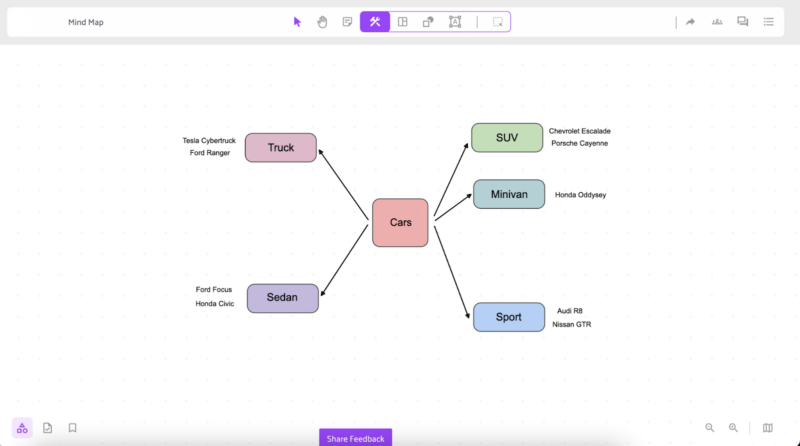No matter how thoroughly you take notes, sometimes you will struggle to grasp the connections between the concepts you’re learning. Mind maps present a unique solution to this problem and offer an intuitive structure to help you learn and retain information.
In this article, we will define a mind map, walk through its main elements, and discuss its applications. Let’s get started.
What is a Mind Map?
Strategic planning is defined as the cornerstone of organizational success, a dynamic process meticulously crafted to define objectives, articulate goals, and forge a comprehensive path forward. Diverging from conventional planning, strategic planning adopts a holistic perspective, meticulously weighing internal strengths and weaknesses alongside external opportunities and threats.
In the intricate tapestry of the business landscape, strategic planning emerges as a masterful roadmap, seamlessly aligning resources with objectives to carve out an efficient and cohesive trajectory. This strategic foresight involves an exhaustive examination of competitive terrain, market trends, and evolving customer needs, empowering organizations to strategically position themselves for unparalleled success.
At the heart of strategic planning lies collaboration, a linchpin fostering a shared vision and commitment across every echelon of the organization. This ongoing process demonstrates adaptability to shifts in the business milieu, championing agility and fortitude.

As seasoned experts in strategic planning, our content transcends conventional insights, delivering actionable tips and best practices for seamless implementation. From strategic management to organizational strategy, we empower businesses not just to navigate complexities but to thrive and achieve sustainable growth.
In the digital realm, our strategic integration of keywords like ‘strategic planning,’ ‘business strategy,’ and ‘organizational development’ propels our content to the forefront, ensuring it shines brightly for those seeking invaluable insights into effective strategic planning.
Recognizing the cognitive prowess of visual learners, our advocacy for visual collaboration in the workplace, particularly in remote or hybrid settings, seamlessly segues into the transformative power of Mind Maps.
Learn more: 10 Benefits of Mind Mapping
How to Build a Mind Map
Mind maps are defined by their signature structure and ability to link elements together through long chains of information. Because of this, they can sometimes be referred to as spider diagrams.
Mind maps are helpful because they are very intuitive and they structure themselves to a certain extent. The first step to building a mind map is understanding the central theme you’re brainstorming.
This central idea is the topic that you’ll explore through the rest of the mind map and everything will radiate outwards from here. This can be a specific problem, a general idea, a broad concept, or simply a thought you have.
Before you begin brainstorming there’s one more step that needs to be clarified: your end goal. Mind maps are really helpful when organizing ideas and can help boost creativity, but in order to work effectively, you need an end goal in mind.
For example, if my mind map is associated with cars, there are a million different things to think about. Am I looking to buy a car? Am I thinking about cars I don’t like? Am I thinking about the parts that make up the car? Am I thinking about which cars are from different parts of the world?
There are a ton of things that I could focus on, and if I’m not ready to select one (or a few) then it will be hard to navigate the mind map effectively.
That being said, mind maps are good because they give you the ability to brainstorm many different things all at once. While it’s always important to focus on your specific goals, mind maps will allow you to branch out in a ton of different directions and get creative with your brainstorming.
After you have your main goal located, you can begin creating branches of related information that fall under the main category.
The first branches are first-level associations, and after that are second-level associations, and so on and so forth.
These associations will always be connected to the piece of information before and will get more and more specific as you move down the line.
When creating each branch of information, you will move from the highly general to the very specific, closing in on singular applications of high-level ideas. This gives you the flexibility to specify multiple different buckets of ideas, and then move forward with their unique applications within each branch.
While you need to keep the associations as vague as possible, you also need to keep them brief. Mind maps are used to summarize information and hopefully create an association that is inherent without explanation. This means that each idea should be one or two words, not a whole sentence.
Having short associations also gives more freedom for your team to interpret them in different ways, providing a unique perspective to the brainstorming process.

When creating associations, it’s important to group them along with their similarities. For example, if we’re using a mind map for cars, the buckets “SUV” and “Minivan” should be relatively close, while the buckets for “sport” and “truck” will be completely separated from one another.
Having different lengths of lines for similar/different associations allows you to better understand the relation between them and how they interact with the main theme.
If you’re creating a mind map that has a ton of different elements, it can get kind of crazy. One way that you can differentiate these visual elements is by using colors and styles. Using different colors, lines, and text helps your brain distinguish different elements from one another and adds a unique touch to each other.
Learn more: 7 Common Mind Map Questions Answered
Mind Map Applications
Seeing as mind maps are great visualization tools for general use, you might struggle to apply them directly to your business. Here are some of the most popular applications for mind mapping.
Brainstorming
Brainstorming is effectively just the process of finding new ideas based on a problem or theme, and mind maps are a simple organizational tool for just this.
Mind maps are able to create a structure that is accommodating for any potential relationships, and their simple and shared nature can help improve collaboration for your whole team.
People may see an idea and think of a unique application of it, or it might prompt them to think of something completely unrelated that has other important applications. Simply seeing these ideas diagrammed on a shared board is huge for collaboration and helps push your brainstorming sessions to the next level.
Organized Note Taking
Sometimes when taking notes you can find yourself down complicated rabbit holes of bullet points, arrows, and unrelated jargon.
Utilizing a mind map is a great way to diagram relations between elements and create a very memorable organization that you can refer back to and grasp instantly.
Problem-Solving
Sometimes all you need to solve a problem is some creative differential. Mind maps help push people to think creatively and in buckets, which helps the rest of the team organize their thoughts as well.
Teams using mind maps for problem-solving help push each other to think creatively about the overall problem they’re analyzing and think critically about the relationship between the solution and the problem.
This is much harder to do without the visual structure provided by mind maps, making them a great tool for problem-solving.
Studying and Memorizing Information
As we previously stated, mind maps are laid out to specifically help the brain comprehend information. The sequential structure they create makes information much more digestible to people and creates an obvious relationship between the different levels of associations.
This means mind maps make the perfect structure for studying and memorizing information, whether it be in school or at work, and are literally built to improve retention.
Summarizing Relationships
Mind maps are all about relationships. This could be the relationship of the main theme to the smaller associations, or even the associations to one another.
If you’re having a hard time summarizing the relationships between multiple elements, a mind map would be the perfect tool to utilize.
Outlining Presentations or Documents
Similar to summarizing relationships, mind maps make a great organizational tool for outlining a presentation or document that you’re trying to digest.
Putting this information in an organized diagram is an effective way to document it and also create a comprehensible flow of how it operates.
Simplifying Project Management
Project management might be a field that you think wouldn’t utilize mind mapping, but in reality, they are actually great at breaking down projects into simple tasks and organizing them into buckets.
Much of project management is organizing the project and tasking it out to your team, and there’s no easier way to create a shared project interface than building a mind map.
Mind maps allow you to create different buckets of tasks that are all structured around their priorities, and all relate to the overall shared goal. This map can be shared by multiple different teams if necessary and will help communicate ideas to all of them.
Learn more: How to create a mind map?
How to Collaborate on a Mind Map
If you couldn’t already tell, mind maps are a great tool to facilitate collaboration within your teams. We call this visual collaboration, which is defined as: “Visual collaboration is the practice of workplace collaboration driven by technology. It hinges on the ability for people to collaborate using visual elements as tools to expand their understanding and communicative abilities”
Mind maps represent everything good about visual collaboration and their visual approach to problem-solving and brainstorming makes them an amazing tool to use with your team.
Using them with an online whiteboard like IdeaScale Whiteboard is the best way to collaborate on them in real time and build them in collaboration with your peers. Online whiteboards allow you to prioritize, brainstorm, and organize the mind map all on the same platform. The best part is after you’re done you can cement it in digital permanence.
These capabilities make mind maps a perfect tool for collaborative brainstorming and one that your team should definitely invest in.
Conclusion
Using a mind map is an exercise that many teams will find value in, and if you’re struggling to grasp the relationship between multiple concepts this is the perfect tool to use.

